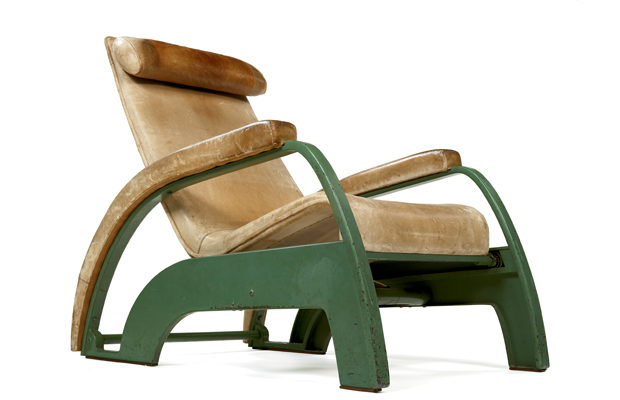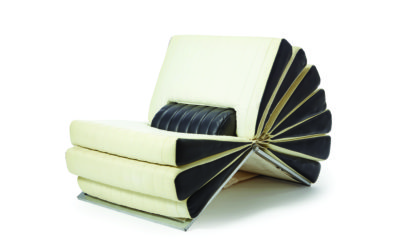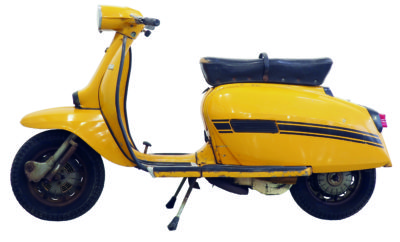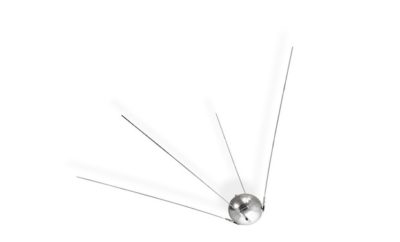
Design
“Grand Repos” designed by Jean Prouvé

Lot 35 Artcurial/ Briest-Poulain-F. Tajan “Jean Prouvé ‘Structure Nomade’ et pièces de mobiliers historiques de Charlotte Perriand, Le Corbusier, Jean Prouvé et Pierre Jeanneret” sale in Paris, October 24: A sheet metal and leather fauteuil “Grand Repos” designed by Jean Prouvé in 1930. Estimated at € 250,000-300,000 (approximately $350,000-420,000) The piece sold for € 471,434 (about $660,100).
Some reasons for the unexpectedly high price:
In the limelight
It is clear from leafing through the auction catalogue that the importance and rarity of this piece was taken into consideration in planning the sale, which in itself could be seen as an ode to Prouvé. The auction included works by a handful of his contemporaries and collaborators, but the spotlight was on Prouvé. The importance of the fauteuil “Grand Repos,” as he called this easy chair, was made known by the full-page black-and-white photograph gracing one of the opening pages of the catalogue, and by a three-page spread with anatomical drawings and photographs accompanying the lot’s description. Out of this fifty-lot sale leading up to the “Structure Nomade”—a 1957 ensemble of three academic buildings originally erected in Villejuif outside Paris—with a dozen of the lots dubbed to be of museum quality, this chair garnered a price second only to the sale’s namesake building. The associate director of Artcurial, Fabien Naudan, commented that “the idea for this particular auction was to be very selective and the surroundings of this piece are very important,” adding that “when the chair previously came to auction in 2006 it was in an art deco sale, which was not ideal because this is a Union des Artistes Modernes [or UAM, a group of French designers formed in 1929 who rejected the lushness of furnishings by Èmile-Jacques Ruhlmann and others] piece and has a different aesthetic.”
Going way back
The design of the chair exhibits a superb combination of the talents of Prouvé—who began his career as a metalworker—as an architect, industrial designer, and furniture designer. Prouvé’s furniture cannot be discussed without taking into consideration his beginnings at the forge because metal figures so prominently in his designs, and particularly in the engineering of the base of this chair. He opened his first workshop in 1923, and became one of the founding members of the UAM in 1929, along with other visionaries of French modernism such as Le Corbusier, Pierre Jeanneret, and Charlotte Perriand, whose works were also included in the Artcurial sale.
Three’s a charm
This model, previously owned by a Swiss private collector who purchased it at an Artcurial sale in 2006, is a remarkably original design. A prototype was presented at the Exposition UAM in 1930, yet it is actually the third in a series of easy chairs designed by Prouvé, the first of which outfitted several of his family’s residences up until its acquisition by the Centre Pompidou in 1993. The second sold at Sotheby’s in Monaco in 1986 and is now part of the collection of the Vitra Design Museum in Germany. These three models each have varying details, though this 1930 design is considered the most successful.
Making green easy
Beneath its wheat-green (“blé vert”) finish this chair’s sheet-metal body is a remarkable technological feat—mounted on rolling ball-bearings that slide along two rails integrated into the base, with springs placed below the seat on either side to allow the seat and backrest to gently recline into a sleeping position and return upright by a simple, natural forward movement on the part of the sitter. On the right-hand side a lock button can be used to keep the back from reclining. The seat, arms, and headrest are covered with original waxed leather. And, as the catalogue indicates, this design is evidence of a particular command of an aesthete who appreciates his comfort.
Growing interest in Prouvé and modernism
Without a doubt, the price this piece achieved is proof of increasing interest in modernism as a whole, and especially of the importance of Prouvé’s role in shaping French modernism. When asked why the estimate was set so high, Naudan remarked that “much more is known about him than when this piece was sold in 2006 and the market for Prouvé is more mature. We know people will pay a very high price for the quality.” This was reflected on the floor, with three bidders taking the piece above the high estimate of €300,000, the lot finally going to a European buyer not usually known for collecting works of French modernism. Clearly modern design, as they say, has legs.












